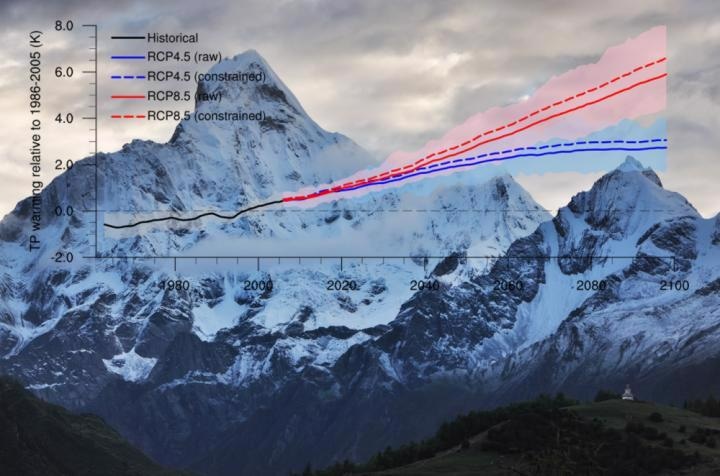Apr 7 2021
Over the last few decades, the Tibetan Plateau, called 'the roof of the world,' has warmed up more quickly compared to the global average.
 Projected future warming of the Tibetan Plateau in the CMIP5 ensemble. The thick curves indicate the multi-model ensemble means and the shadings denote the 90% model intervals, derived from the raw model output. The dashed curves indicate the constrained projections based on the attribution result. Blue and red represent a medium (RCP4.5) and high (RCP8.5) greenhouse gas emission scenario, respectively. Image Credit: Wenxia Zhang.
Projected future warming of the Tibetan Plateau in the CMIP5 ensemble. The thick curves indicate the multi-model ensemble means and the shadings denote the 90% model intervals, derived from the raw model output. The dashed curves indicate the constrained projections based on the attribution result. Blue and red represent a medium (RCP4.5) and high (RCP8.5) greenhouse gas emission scenario, respectively. Image Credit: Wenxia Zhang.
The warming observed in the Tibetan Plateau dating from the 1960s can be linked to human activities, especially greenhouse gas emissions. The Plateau might warm quicker in the future compared to what climate models project, notes a new study published recently in the Environmental Research Letters journal.
Besides the Arctic and Antarctic, the Tibetan Plateau consists of the highest volumes of ice and feeds water to dozens of significant Asian rivers. But the quick warming of the 'Water Tower of Asia' has considerably impacted the regional hydrological cycle and ecosystem services.
This has resulted in a notable glacier retreat and geohazard disasters like debris flows, glacial lake explosions and landslides.
A clear understanding of the past warming of the Tibetan Plateau, particularly the underlying human influence, can help better anticipating and interpreting future changes.
Tianjun Zhou, Study Lead and Corresponding Author, Senior Scientist, Institute of Atmospheric Physics and CAS Center for Excellence in Tibetan Plateau Earth Sciences, Chinese Academy of Sciences
Zhou is also a professor at the University of Chinese Academy of Sciences.
Zhou and his colleagues employed CMIP5—an archive of extensive climate models, in which historical simulations are forced by separate external influences—to unravel and measure the relative contributions of various external influences in the observed warming.
The researchers used an ideal fingerprinting detection and attribution analysis to show that human impact is the predominant driver for the observed warming of the Tibetan Plateau (1.23°C from 1961 to 2005), with greenhouse gases specifically contributing around 1.37°C, which was somewhat offset by anthropogenic aerosols.
Through a quantitative comparison of observations and modeled responses, the attribution analysis shows that the CMIP5 ensemble and present global climate models undervalue the anthropogenic warming trend that takes place on the Tibetan Plateau.
The researchers took this into account and went on to rectify future projections by making use of the attribution result as an observational constraint. They discovered that the Tibetan Plateau will probably warm faster compared to what was anticipated in the future.
For example, under a medium carbon emission scenario (RCP4.5), the Tibetan Plateau is expected to warm by 2.25 °C and 2.99 °C in the mid-term (2041-2060) and end of 21st century (2081-2100), which are 0.24 °C and 0.32 °C warmer than the uncorrected projections, respectively. This implies a greater loss of glacier mass and further increased geohazard risks in the Asian water tower.
Wenxia Zhang, Study Second Author, Institute of Atmospheric Physics, Chinese Academy of Sciences
Journal Reference:
Zhou, T., et al. (2021) Anthropogenic warming of Tibetan Plateau and constrained future projection. Environmental Research Letters. doi.org/10.1088/1748-9326/abede8.